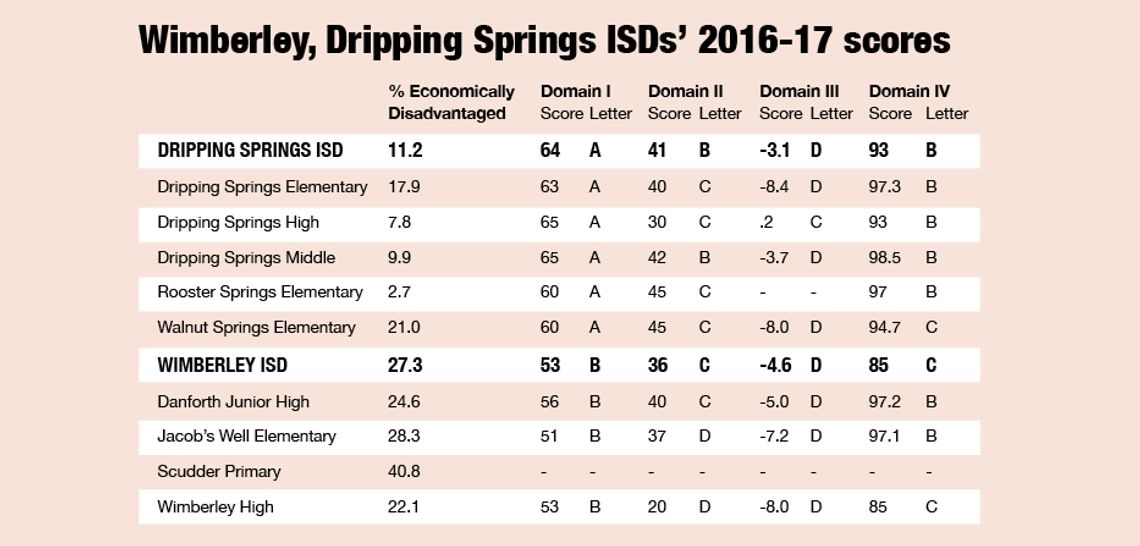[dropcap]A[/dropcap]n A, two Bs and one D were the letter grades Dripping Springs ISD received as part of the preliminary “report card” from the Texas Education Agency’s new A-F accountability system.
DSISD officials, however, maintain their stance in opposition to the state’s new system, which is not slated to to into effect until the 2018 school year.
Bruce Gearing, DSISD superintendent, said while the district embraces “meaningful accountability” that informs students, parents and teachers about the learning needs in the district, the new system isn’t the right way to go.
“We simply do not believe the proposed A-F system is the right tool and hope that the legislature will direct TEA to develop a more community-based accountability system,” Gearing said in a statement.
The state’s new rankings were released Monday and are intended to be a snapshot of what the new system would look like if it were implemented this year. According to the rankings, DSISD received an A in Domain I, which measures student achievement. The district received a B in Domain II and IV, which measures student progress and postsecondary readiness.
However, the district received a D rating Domain III, which is closing performance gaps.
In December 2016, the DSISD board of trustees passed a resolution opposing the state’s new A-F rankings.
Dripping Springs is one of over 100 school districts that have passed resolutions in opposition to the state’s new accountability ranking system.
Later this month, Hays CISD plans to bring to the board of trustees a resolution that opposes the state’s new system.
In a letter to parents, HCISD superintendent Michael McKie said the new system is “deficient in capturing all of the positive things happening in our classroom.” He added the current method which the grades are calculated relies “heavily” on the high-stakes test administered by the state.”
“In fact, this new rating system is damaging because it creates a false impression about students, ignores the unique strengths of each school, and unfairly reduces each student’s worth to the school’s assigned grade,” McKie said in a statement.
What is the TEA assessing?
Domain I – Student achievement
Domain I measures STAAR assessment results combined across all grades and subjects. One point is awarded for each percentage of assessment results that are at or above the following: Level II Satisfactory Standard, Postsecondary Readiness Standard and Level III Advanced Standard.
Domain II – Student progress
Domain II measures progress at the STAAR satisfactory and postsecondary readiness standards on ELA/reading and mathematics assessments. One point is awarded for each percentage of assessment results that meet or exceed progress measure expectations and one point for each percentage of assessment results that exceed progress measure expectations. Performance is calculated for ten student groups: All students, Pacific Islander, African American, White, American Indian, two or more races, Asian, students served by special education, Hispanic and English language learners.The performance of all ten groups is combined to determine the Domain II score.
Domain III – Closing performance gaps
Domain III measures academic performance differentials among students from different socioeconomic backgrounds. The score is based on the relationship of a district or campus’ Domain I score and the percentage of its students who are economically disadvantaged. Using statewide data from the 2015–2016 school year, TEA determines a predicted Domain I score (using assessment results of only the economically disadvantaged subgroup), based on district or campus type and the percentage of students who are economically disadvantaged. For the purposes of calculating the Domain III score, this specialized Domain I score is referred to as the Domain IDIII score. The difference between a district or campus’s Domain IDIII. score and the predicted Domain IDIII score is the district or campus’s Domain III score. TEA provides a formula for districts and campuses to use to calculate their predicted Domain III score.
Domain IV – Postsecondary Readiness
Domain IV measures whether students are on track for success in postsecondary life, whether in college, a career, or the military. The indicators used to measure postsecondary readiness vary by campus type. Scores for elementary schools are based on the chronic absenteeism rate calculated by student group. Scores for middle schools are based on the chronic absenteeism rate and the annual grade 7 and 8 dropout rate, if available. If a dropout rate is not available, the Domain IV score will be based solely on the chronic absenteeism rate. High Schools, K–12 Campuses, and Districts Domain IV scores for high schools, K–12 campuses, and districts are based on graduation/dropout rates, graduation plan rates, and college and career readiness indicators.











